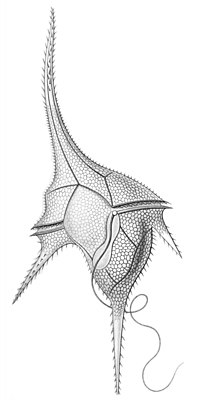
Photo from wikipedia
Karenia mikimotoi is a toxic dinoflagellate that forms harmful blooms in coastal waters, threatening aquaculture worldwide. However, we do not know whether K. mikimotoi has a neurotoxic effect on aquatic… Click to show full abstract
Karenia mikimotoi is a toxic dinoflagellate that forms harmful blooms in coastal waters, threatening aquaculture worldwide. However, we do not know whether K. mikimotoi has a neurotoxic effect on aquatic animal behavior. Thus, this study investigated potential K. mikimotoi neurotoxicity in zebrafish larvae. Cells of K. mikimotoi were collected at the mid-exponential phase from a batch culture to prepare ruptured cell solutions (RCS). At 6 h post-fertilization (hpf), zebrafish embryos were exposed to different RCS concentrations (0, 102, 103, 104, and 2.5 × 104 cells mL-1). After 120 hpf, treated larvae were collected to analyze locomotor behavior; activities of acetylcholinesterase (AChE), superoxide dismutase (SOD), catalase (CAT); and expression of genes related to neurodevelopment. We found that RCS did not affect survival rate, but significantly decreased larval locomotion, as well as their AChE, SOD, and CAT activity. Additionally, the examination of the day-night behavioral experiment revealed RCS decreased locomotion only at night. Zebrafish larvae were also significantly hypoactive in response to light and sound stimulations. Of the neurodevelopment genes, three (th, neurog1, and neurod1) were downregulated, while two (bdnf and manf) were upregulated. Our study suggests that K. mikimotoi neurotoxicity occurs through causing oxidative damage, as well as disorders in the cholinergic system and nervous system development. The results provide new insight that K. mikimotoi in low abundance did not cause significant lethal effect but still exhibited significant neurotoxicity on aquatic animals.
Journal Title: Harmful algae
Year Published: 2021
Link to full text (if available)
Share on Social Media: Sign Up to like & get
recommendations!